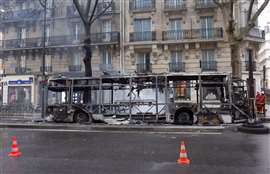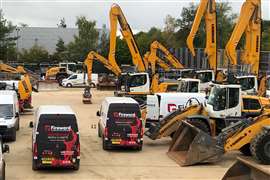Read this article in 中文 Français Deutsch Italiano Português Español
Extinguishing EV fires poses unique challenges
05 February 2024
When lithium ion batteries catch fire, they burn differently from internal combustion engines. Fighting those fires poses difficulties in vehicle fire suppression.
 A demonstration of the e-FireX fire suppression agent extinguising a lithium battery fire. (Photo: e-FireX)
A demonstration of the e-FireX fire suppression agent extinguising a lithium battery fire. (Photo: e-FireX)
Effectively fighting any fire means understanding how the fire started. With vehicle fires, that largely means knowing the vehicle’s power source. There was a time when it was exclusively an internal combustion engine (ICE). The proliferation of electrified vehicles and equipment, however, has changed that — and introduced certain challenges.
“The difference is that [internal] combustion fires have an incipient phase,” said Jesse Corletto, retired firefighter and founder of e-FireX, a Reno, Nev.-based maker of fire suppression agents for lithium battery fires. “They need oxygen to build — to get to that 1800° F (982.2° C) — and then to get all the material around the car to burn, to get to that range.”
Corletto said that by comparison, a lithium ion battery fire doesn’t have an incipient phase because “it creates its own oxygen,” i.e. releases oxygen when the battery burns. “It goes from zero to 3000° F (1648° C) immediately.”
Thermal Runaway Challenges
According to “Fire Protection and Life Safety Myths,” a Jan. 3, 2024 blog post by Shawn Mahoney on the National Fire Protection Association (NFPA) website, this rapid combustion process is called thermal runaway, “where a single cell failure can cause the production of heat and oxygen as well as flammable and toxic gases. This then spreads to adjacent cells causing potential rapid fire growth or explosions.”
 The burnt-out remains of an electric bus in Paris on April 4, 2022. Two Bluebus vehicles from the public RATP transport company caught fire in April 2022, forcing the operator to temporally withdraw all electrical buses from its fleet. The fires were reportedly due to battery issues. (Photo: Mehdi Chebil/Hans Lucas via Reuters Connect)
The burnt-out remains of an electric bus in Paris on April 4, 2022. Two Bluebus vehicles from the public RATP transport company caught fire in April 2022, forcing the operator to temporally withdraw all electrical buses from its fleet. The fires were reportedly due to battery issues. (Photo: Mehdi Chebil/Hans Lucas via Reuters Connect)
Thermal runaway makes it more challenging to fight an EV fire than an ICE fire. “They burn so fast and so hot that any agent out there on the market right now — water, powder, gels, foams — it all evaporates before it gets to the seat of the fire,” Corletto said, adding that lithium battery fires can reach 4000° F.
The challenge of fighting EV fires prompted Corletto to establish e-FireX two years ago. “I just realized there’s really nothing out there as far as [fire suppression] innovation for keeping up with the trend of the EV market. So I started working on developing a new agent that could combat this type of high-heat fire with EVs. And what I realized is that the fire suppression market has not caught up yet with the EV market.”
Ineffective Suppression Agents
He added that while vehicle fire suppression systems have been available for a long time, equipment manufacturers often fail to realize that the fire suppression agents they use are not compatible with fighting an EV fire.
“They know they’re building something that’s a great product that obviously is going to save the environment, save a lot moving forward,” Corletto said. “But at the same time, they need to provide that extra essence in protecting the customer.”
He added that also means protecting customer assets around EVs that could be damaged or destroyed in a fire. “That farming equipment might be inside a barn when it goes off. Not only are you just going to lose that farming equipment — you’re going to lose your whole barn, because once that thing catches fire, as I mentioned before, it’s from zero to almost 3500 or 3600° F (1926.7 or 1982.2° C) immediately. And there’s no getting close to it — it’s gone. That’s it.”
Regulations Falling Behind
Corletto also said fire regulations themselves have not kept pace with the proliferation of electric vehicles.
 Retired firefighter Jesse Corletto, founder of Reno, Nev.-based e-FireX. (Photo: e-FireX)
Retired firefighter Jesse Corletto, founder of Reno, Nev.-based e-FireX. (Photo: e-FireX)
“They’ve been a little bit behind, and that’s one of the things I realized when I founded e-FireX and started promoting the agent to the markets, to the big manufacturers.”
He added that he did his own research to see if there were any regulations or guidelines specifically related to fire suppression in the EV industry and found that nothing existed.
“I introduced a new classification to NFPA for fire extinguishers,” Corletto said. “Currently lithium is a placeholder on the [Class] D metals classification for fire extinguishers,” Corletto said. “And that agent in the D metal currently out on the market does not extinguish lithium, just because of the way it burns. With the e-FireX formula, I introduced a new classification, removing that lithium out of that D category and into the lithium category, and presented it to NFPA last year.”
He added that regulatory agencies should work together to address the fire suppression challenges related to EVs. “We really need OSHA, NFPA, IFC (International Fire Code) — they all need to come together and really work hard to protect the consumer and save a life.”
POWER SOURCING GUIDE
The trusted reference and buyer’s guide for 83 years
The original “desktop search engine,” guiding nearly 10,000 users in more than 90 countries it is the primary reference for specifications and details on all the components that go into engine systems.
Visit Now
STAY CONNECTED




Receive the information you need when you need it through our world-leading magazines, newsletters and daily briefings.
CONNECT WITH THE TEAM















